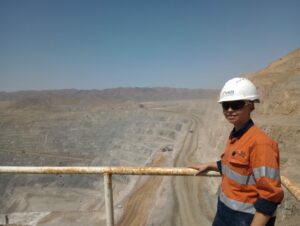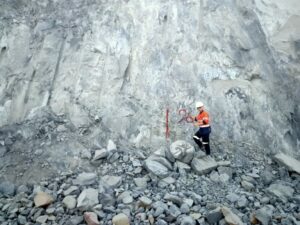London – 17 February 2023: Women in Mining UK 2022 Summer Internship at Centamin PLC – Ursula Shaw
Written by: Ursula Shaw
I am a recent Earth Sciences graduate from the University of Cambridge and the fortunate recipient of a Mine Geologist internship with Centamin PLC, a FTSE 250 gold miner and Industry Partner of Women in Mining UK (WIM UK). Thank you to WIM UK and the Mineral Resources Management team at Centamin for the opportunity.
 The eight-week internship commenced in September 2022 and took place onsite at the Sukari Gold Mine, Centamin’s flagship operation in southern Egypt. The Sukari orebody was a commercial discovery of Egyptian modern explorers in the 1990s and led to the start of open pit mining in 2009 and underground mining in 2011. Running both open pit and underground developments, and with a mine life of at least 12 more years, Sukari was a fantastic place to learn the ropes.
The eight-week internship commenced in September 2022 and took place onsite at the Sukari Gold Mine, Centamin’s flagship operation in southern Egypt. The Sukari orebody was a commercial discovery of Egyptian modern explorers in the 1990s and led to the start of open pit mining in 2009 and underground mining in 2011. Running both open pit and underground developments, and with a mine life of at least 12 more years, Sukari was a fantastic place to learn the ropes.
The Scope of the Internship
The days began with a 40-minute drive from Marsa Alam, a Red Sea coastal town, into the desert and toward site. I spent the first couple days with Centamin’s sustainability intern, Pheobe Dawes, for a general safety induction and introduction to the onsite fleet of vehicles and their maintenance requirements, the power plant (now integrated with a 36Mw per annum solar plant), processing plants (crushers, mills, regrinding circuits and flotation tanks) and a view of the open pit operations. A memorable takeaway was the awe and adjustment to the scale of operations – the size of the open pit, 785C CAT truck tyre and 150-tonnage truck load of granitoid rock!
From a technical perspective, the internship was diverse. I spent time with geologists working onsite in Projects & Exploration, Open Pit, Underground and Resource Estimation. I also had the chance to spend a few days offsite with Centamin’s Eastern Desert Exploration (EDX) team. This permitted the opportunity to log diamond drill core and reverse circulation drill cutting, interpret sections by hand from core logging data, data entry & retrieval via Fusion, map open pit walls & floor and underground faces, produce mapping reports, digitise maps in Leapfrog, explicit modelling of domains from section interpretations in Vulcan and MicroMine, and exploration-phase traverse mapping.
By the end of the eight weeks, I was able to appreciate the work geologists undertake within the context of a mining operation. Geological expertise is required at the point of data collection, enacting protocols for quality assurance and quality control concerning techniques applied to sampling, assaying, data entry, data storage and error management, modelling gold mineralisation, overseeing post-blast material movement and reconciling production figures with those planned.
A Bite for Geology Lovers
 Like many earth sciences undergraduates in the UK, I was introduced to geological mapping in the soggy fields of Cumbria where bedrock exposure can only be found at river banks or otherwise inferred from sinkholes. The arid surface conditions in Egypt’s eastern desert by contrast provides abundant exposure – you can see the rocks! Thousands of years of little to no erosion have left these rocks coated in a dark ‘desert varnish’ concoction of manganese oxide layers and entrapped clay minerals. It takes a day or two for the eye to adjust for the shades of brown to turn into exotic oranges and blues; the colours of carbonate-altered serpentinites, ophiolitic suites and greenschist facies metavolcanics that can be found in the arc accretionary sequences regional to Sukari.
Like many earth sciences undergraduates in the UK, I was introduced to geological mapping in the soggy fields of Cumbria where bedrock exposure can only be found at river banks or otherwise inferred from sinkholes. The arid surface conditions in Egypt’s eastern desert by contrast provides abundant exposure – you can see the rocks! Thousands of years of little to no erosion have left these rocks coated in a dark ‘desert varnish’ concoction of manganese oxide layers and entrapped clay minerals. It takes a day or two for the eye to adjust for the shades of brown to turn into exotic oranges and blues; the colours of carbonate-altered serpentinites, ophiolitic suites and greenschist facies metavolcanics that can be found in the arc accretionary sequences regional to Sukari.
